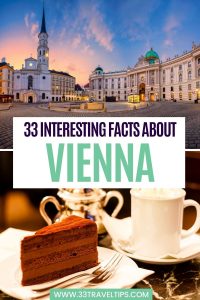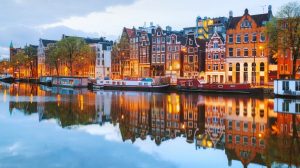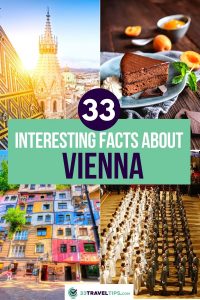
Delectable food and drinks.
Teems of historical and cultural landmarks.
The highest quality of living in the world.
All these describe Vienna, the capital of Austria.
But did you know that the city is home to the oldest operating Ferris wheel in the world?
Or that you can dress like royalty and spend the night in a palace?
If you find these fun, explore the other interesting facts about Vienna we’ve prepared for you.
Let’s start, shall we?
Start Planning Your Trip to Vienna with Our BEST Recommendations:
⭐ Top Tours in Vienna ⭐
📍 Strudel Show at Schönbrunn Palace – this is our top recommendation to experience the traditional Viennese apple strudel in a regal setting.
📍 Hallstatt & Alpine Peaks Day Trip – breathtaking peaks, serene lakes, and quaint villages await you on this day trip to Hallstatt. Join before it’s fully booked!
⭐ Best Accommodations in Vienna ⭐
🏨 Steigenberger Hotel Herrenhof – affordable luxury lodging in the historic center.
🏨 Schönbrunn Palace – stay in one of Europe’s most staggering palaces.
⭐ Easiest Transportation Options in Vienna ⭐
🚍 Vienna City Card – enjoy discounts, free travel, and entrances to museums.
🚍 Discover Cars – compare and find the best rates for car rentals.
✅ Note: This article contains affiliate links. In case you purchase something through one of these links, we may receive a small commission at no extra cost to you. Thank you for helping us keep creating the free content on this website!
Fascinating Facts about Traditional Viennese Foods and Drinks

Vienna packs a delectable punch of foods and beverages. If you’re a food lover, you’re in for a regal treat. Prepare to salivate!
- The origins of the French croissant are, in fact, Viennese. This fact might shock you, but the world-famous French pastry begins its journey in the Austrian capital city. Croissants, as we know them today, can be traced back to the Austrian Kipferl (German for crescent). When the Austrian army defeated the Ottoman Turks in 1683, Viennese bakers celebrated the victory by making Kipferls. The crescents on the enemy’s uniforms were the inspiration. After the marriage between Marie Antoinette of Austria and King Louis XVI of France in 1770, the pastry made its way to the French Court and eventually became popular across the country.
- Vienna is known as the Wine City. Wine lovers will appreciate Vienna’s continuous effort to produce wine. There is no other city in the entire world that has more vineyards within its limits than the 1,700 acres the Austrian capital boasts. The Viennese produce around 660,000 gallons of white wine each year. That’s a lot of glasses to raise!
- The classic Viennese sausage has many names. The so-called wiener stands for “Viennese” in German. A Frankfurt-born butcher invented the sausage after he’d already moved to the Austrian capital. This fact explains the name Frankfurter, which is used in Vienna. In other countries, people refer to the dish as a Vienna sausage. Regardless of how you call it, you must try it.
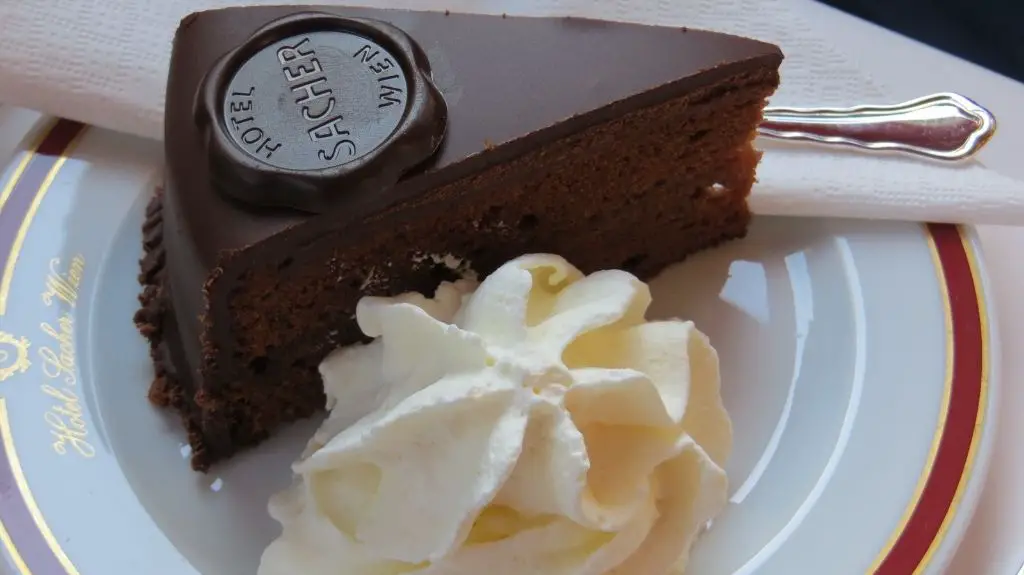
- The Sacher Torte is one of Vienna’s most famous creations. Back in 1832, Prince Metternich wanted to try a new dessert. Unfortunately, the chef was sick and his young apprentice – Frank Sacher had to come up with something. Only 16 years old at the time, Sacher created one of the most popular cakes in the world. When in Vienna, make sure you try it at the Café Sacher.
- The traditional Viennese coffee houses are on the UNESCO Cultural Heritage list. Everyone needs to experience the Viennese coffee culture. The unique atmosphere of these establishments is often preserved unchanged for centuries. The history of the cafés in the Austrian capital traces back to the 17th century. They still have an important role in the city’s social life. Last but not least – the vintage coffee houses serve delicious drinks on marble tables. Now, that is something special.
- The Viennese celebrate National Wiener Schnitzel Day. Austria’s national dish, the Wiener Schnitzel, is celebrated on September 9th. The mouth-watering meal is best prepared following the classic recipe. Thin veal cutlets are pounded and covered in a mix of breadcrumbs and eggs, then fried for a few minutes. The resulting foodgasm is often larger than the plate it is served on. Warning: you should never eat your schnitzel with a sauce.
Curious Facts about Vienna’s Rich History and Culture
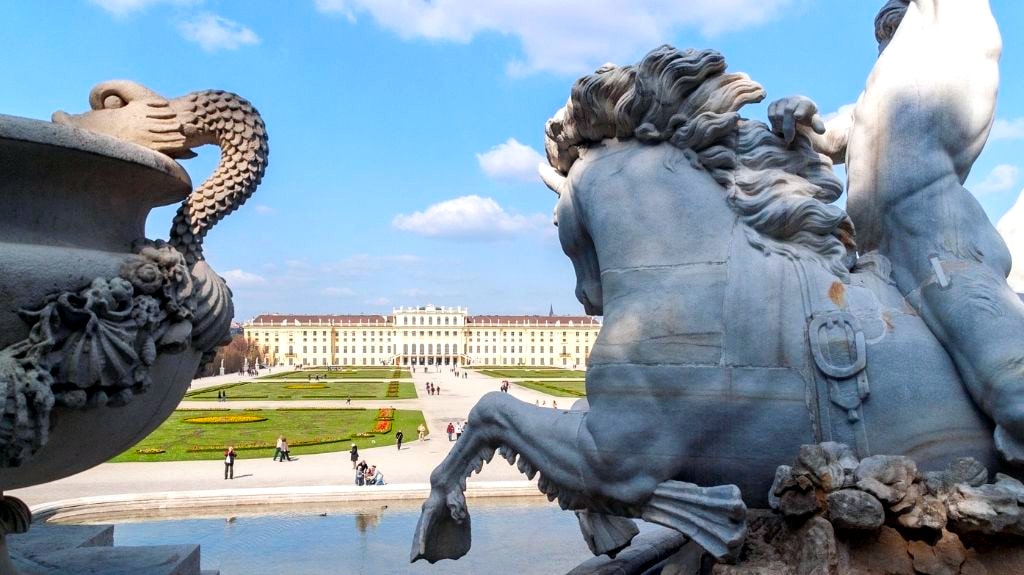
The Austrian capital abounds in historical and cultural landmarks. You can feel like a star in a Disney movie while waltzing the night away during a ball or spending the night in a palace. Let’s discover the most peculiar facts about the attractions which make Vienna worth visiting.
- The famous Schönbrunn Palace has more than 1,440 rooms. To refer to the summer palace of the Habsburg family as impressive would be an understatement. The name translates as “beautiful spring”, and its magic attracts roughly 3 million tourists per year. The coolest thing is that you can spend the night in the palace. The price range of $600-$1,800 is nothing to sneeze at, but you’ll also have the chance to dress like royalty.
- The oldest zoo in the world is in Vienna. The history of the Tiergarten Schönbrunn began in 1782 when Emperor Francis Stephen of Lorraine ordered the construction of a menagerie for the royal family to enjoy. The oldest zoological garden in existence is now home to about 700 species, including endangered ones. It’s on the UNESCO World Heritage Site list as well.
- Vienna was divided in the aftermath of WWII. Berlin was not the only city that the Allies separated into sections after the war ended. France, the United States, the United Kingdom, and the Soviet Union occupied Vienna all at once, splitting it into four parts. The ordeal ended in 1955 with the signing of the Austrian State Treaty.
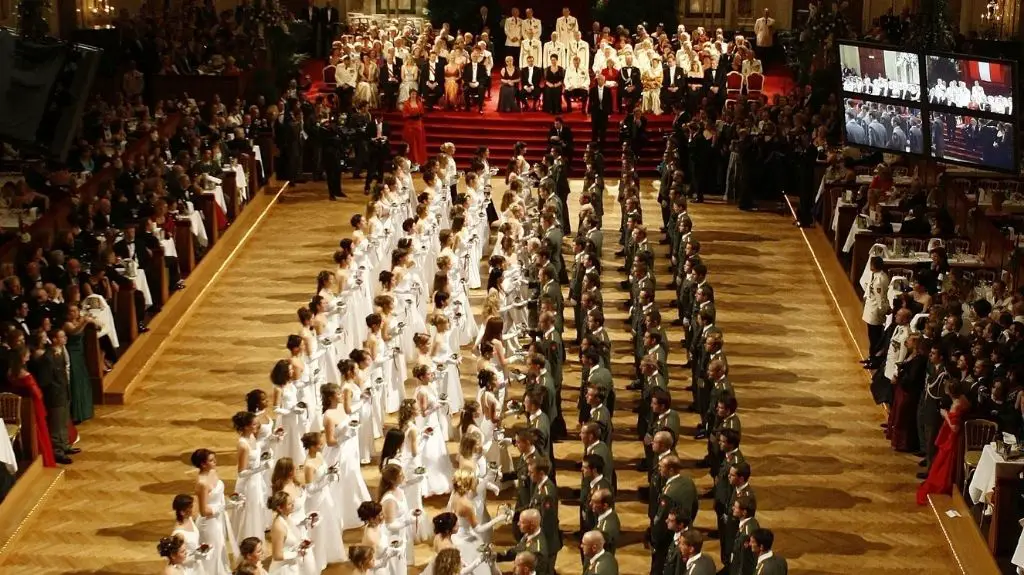
- 450+ balls take place in Vienna each year. These events are undeniably the highlights of the Viennese cultural life and shape the character of the enchanting Austrian capital. The ball schedule is jam-packed during the first months each year – this is when the Carnival takes place. To give you an idea of their scale, we’ll mention that some of the balls incorporate up to nine orchestras! This has to be the most glamorous fact about Vienna on the list.
- The Museum Quarter is Europe’s biggest and most impressive museum complex. 60 cultural establishments spread across a whopping area of 645,000 sq. ft. This makes MuseumsQuartier Wien one of the largest historical and cultural complexes on the planet, and the biggest one on the Old Continent. The area is full of cafés and gift shops, too, creating a great ambiance.
- The Wiener Riesenrad is the oldest operating Ferris wheel in the world. One of the main attractions of the Wurstelprater amusement park dates back to 1897, making it the world’s oldest Ferris wheel. It’s still one of the best and most unusual things to do in Vienna.
Fun, Wacky, and Lesser-Known Facts about Vienna
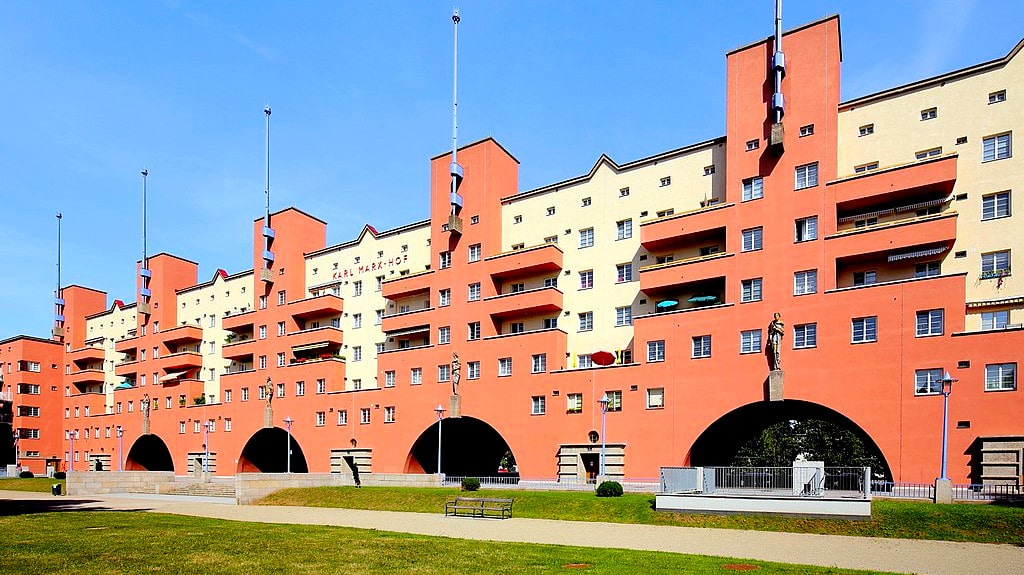
Adopting a rose is a thing in Austria’s largest city. As is drinking tap water from 1,000+ public fountains. Discover the details about these and more fun facts about Vienna below:
- Vienna hosts the longest residential structure in the world. The Karl Marx-Hof is probably the most famous of the so-called Gemeindebauten in Vienna (municipality housing buildings in German). The apartment complex is more than 3,600 ft. long. The land it sits on was part of the riverbed of the Danube up until the 12th century. You can find this signature building in the city’s 19th district.
- You have the chance to adopt a rose in the Schlosspark Schönbrunn or the Volksgarten. Now, this is an exceptional opportunity that many tourists take. For $420, you can have your very own rose in one of the above-mentioned magical gardens for five years straight. You need to sign up first, though, as there is a rather long waiting list for this privilege.
- Vienna’s tap water flows from the Styrian/Lower Austrian Alps. This incredible fact will likely make you taste local tap water while you visit the city. The water comes from Alpine springs and reaches the Austrian capital city in just 36 hours. Meanwhile, it powers two hydroelectric power plants, generating enough electricity for a small town. A couple of mountain spring pipelines supply approximately 400,000 l of fresh spring water daily. Its high quality is notable after taking just one sip. In fact, it’s better than most types of bottled mineral water on the market.
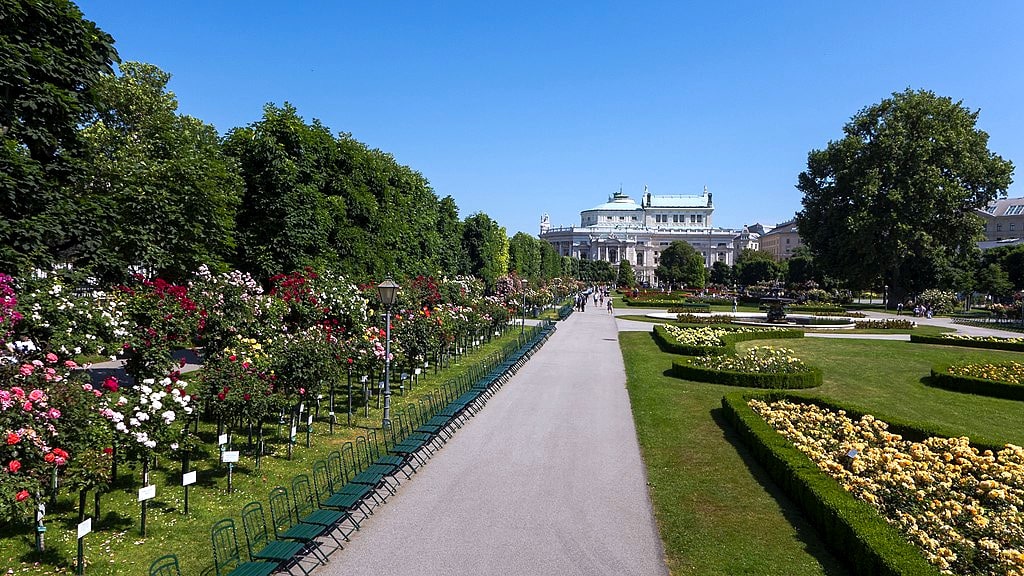
- There are more than 1,000 drinking fountains scattered across Vienna. The same Alpine water is supplied to all the fountains tourists and locals frequently use. This fact about Vienna is very important during summer, as temperatures can rise pretty high.
- Vienna is the birthplace of the PEZ candy. The tiny fun candy bits many of us grew up with trace their origins to the capital city of Austria back in 1927. The name comes from pfefferminz, which is German for peppermint. Nothing to wonder about that, as the first PEZ candy was only available in that flavor. 22 years later, the cool candy dispensers were introduced. They looked like a lighter for a reason – the shape appealed to more clients, as smoking was prohibited at the time.
- Vienna is home to the biggest emerald in the world – Emerald Unguentarium. The Viennese Imperial Treasury (Schatzkammer) boasts the biggest emerald in existence. Skillful jewelers carved this magnificent specimen from an emerald crystal, weighing more than the whopping 3,000 carats. None other than the reigning Habsburg king, Emperor Ferdinand III, commissioned the operation in 1641.
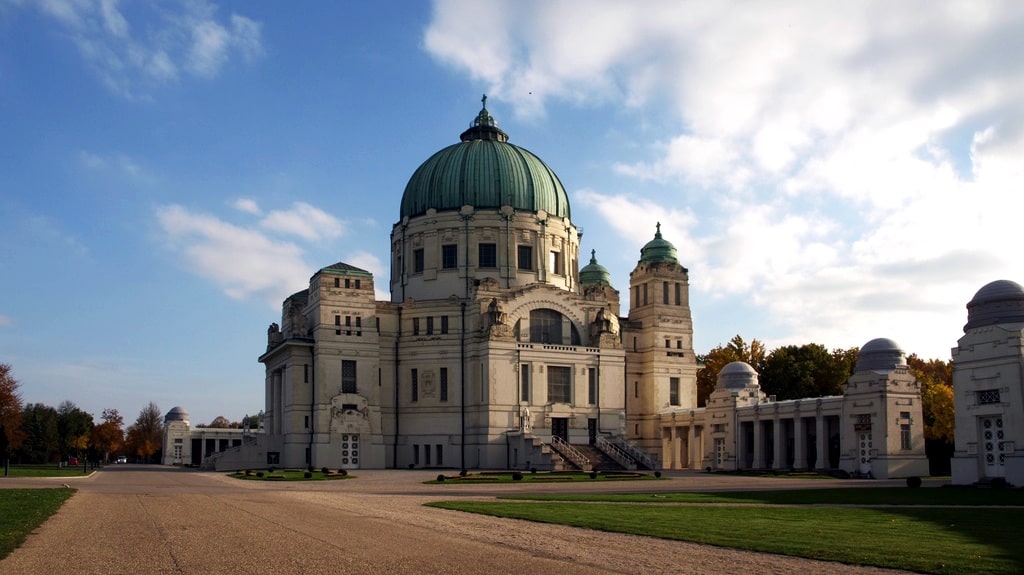
- Vienna Central Cemetery is the final resting place of more than 2.8 million people. The Zentralfriedhof is as extraordinary as the rest of the city. Given the fact that Vienna’s current population slightly exceeds 1.8 million people, it’s not hard to conclude that there are more dead people within the city limits than alive. Spooky, eh?
- The Wiener Zeitung is one of the oldest existing newspapers in the world. The first issue was published in 1703. The newspaper was called Wiennerisches Diarium at first. In 1780, the name changed to Wiener Zeitung and has remained the same since then. The newspaper is the official publication the Austrian Government uses for formal announcements.
- A Viennese mechanic invented the snow globe. The funny thing about this Vienna fact is that Erwin Perzy invented it by accident. One freezing day in 1900, he was experimenting with surgical lamp lightbulbs. The mechanic wanted to make them brighter by adding a mix of water and semolina flakes. The experiment failed, but he created something quite cool which we all love today.
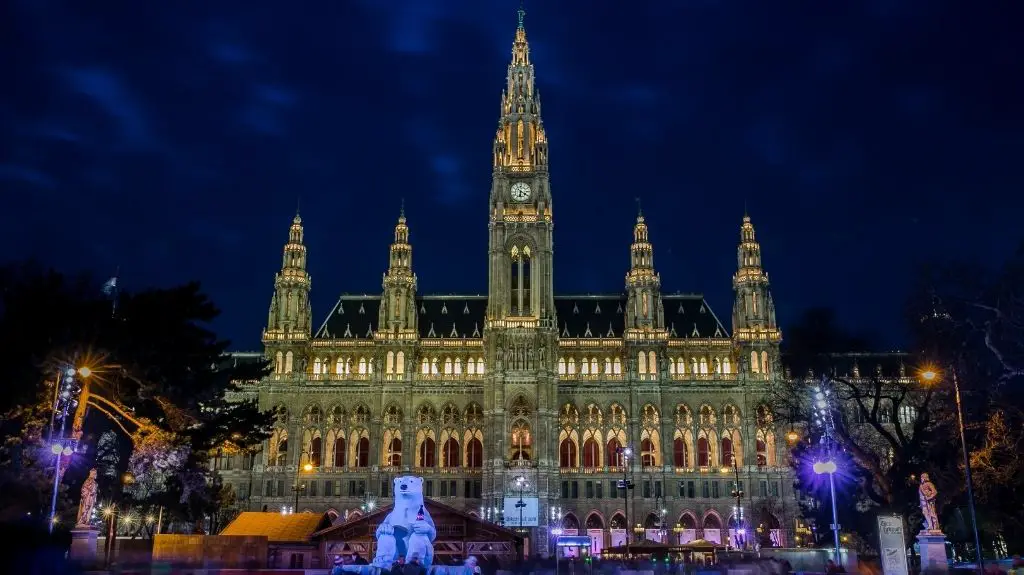
- The Town Hall square turns into Vienna Ice Dream after Christmas. The city’s atmosphere would not be the same without the traditional and remarkably beautiful ice-skating rink. The Wiener Rathausplatz is transformed into this amazing attraction between January and March. The square also hosts one of the best Christmas markets in Europe.
- Vienna is considered the cradle of psychotherapy as we know it. There is no surprise here, as the city was home to some of the greatest minds to ever work in the field, such as Freud and Frankl. The primary reason why the Austrian capital received such recognition is the enormous impact their work had on the rest of the world.
- The oldest preserved house in Vienna is from the 13th century. It is hard to believe, but the tiny Heumühle auf der Wieden is around seven centuries old. Here’s a comparison to give you a better idea of its age: the building was constructed around the time when Genghis Khan became the Great Khan of the Mongols.
- Most city buildings lack air conditioning systems. This is true for both private homes and commercial premises in Vienna. This fact might come as a shock to most tourists, especially when summer temperatures reach 100° F. Still, the solid brick-and-stone buildings manage to keep the rooms cool.
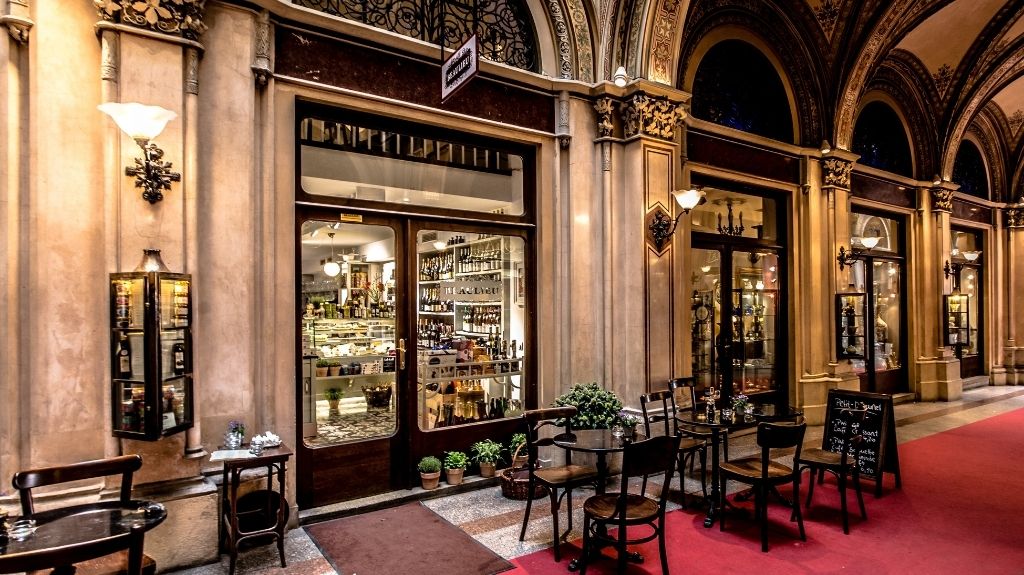
- Vienna offers the best quality of life in the world. This is not just a random opinion. The city has been on top of many ratings evaluating the quality of living in different cities around the world, such as the Mercer Quality of Living Survey from 2019. The Viennese are proud of that title and they know it is well-deserved.
- Vienna is a very dog-friendly city. Canines are welcome pretty much everywhere around the city (and in Austria as a whole). You can take your dog with you while commuting by all means of public transport. Taking the pooch to a restaurant is also acceptable – it will even receive a bowl of water. Of course, all dogs must walk on a leash, and in addition, the bigger ones need to wear a muzzle.
- There is an artificial island in the Danube River. The 13-mile-long island was intended to protect the city from floods. It is also used as a recreational center since the time it opened its doors to visitors back in 1981. It features a water playground, a beach, and the biggest trampoline center in the world.
Facts About Famous People Who Called Vienna Home
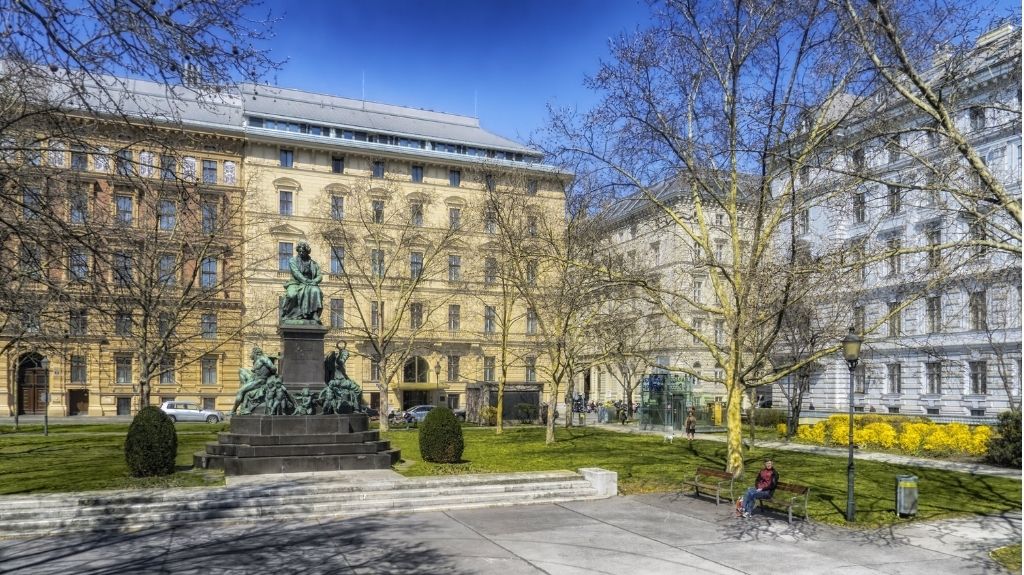
Many historical figures found inspiration for their work while living in Vienna. This section will give you an insight into the influence the Austrian capital had on them.
- Mark Twain lived and worked in the Austrian capital between 1897 and 1899. His stay in Vienna was a valuable experience. The prolific writer loved everything about the city. Its influence on his work during and after the times he lived there is notable. One of the funniest moments during his stay was the speech he delivered in front of the Concordia Press Club. The topic was “Die Schrecken der Deutschen Sprache” (“The Horrors of the German Language”) which Mark Twain presented in German to the spectators’ great amazement.
- A memorial in Vienna celebrates Stalin. Since 1949, the plaque hangs on a hotel wall in the 12th district of the city where Stalin spent a part of his life. There have been numerous attempts for the memorial’s legal removal. This never happened because Austria has signed a post-war treaty for the preservation of the Soviet monuments.
- Many historical figures were practically neighbors at the beginning of the 20th century. 1913 was a truly special year, as Vienna was home to individuals such as Stalin, Trotsky, Freud, and Hitler. On some occasions, these people were living just a few feet apart and even visited the same cafés. That has to be one of the craziest facts about Vienna, right?
- Vienna is called The City of Dreams and The City of Music. The rich cultural heritage of this magical city would have never been the same without the work of the magnitude of composers who called the Austrian capital home. Beethoven, Mozart, Brahms, Mahler, Schubert, and many other composers, artists, and performers were the reason to nickname Vienna The City of Music. Sigmund Freud’s book “Die Traumdeutung” (“The Interpretation of Dreams”) is the reason for the nickname The City of Dreams.
- Mozart’s Requiem sounds godly when performed in the St. Stephen Cathedral. This is one of Mozart’s most famous and touching compositions. It has been played in the world’s best halls, but it sounds utterly marvelous in the Stephansdom. The cathedral’s five organs and the design of the hall create the perfect acoustic for Mozart’s masterpiece.
Facts About Vienna: Gastronomy, Culture, Science, and Entertainment

Vienna will enchant you with great cultural, historical, and culinary experiences.
You can listen to the best classical music inside stunning cathedrals.
You can rub shoulders with real royalties on spectacular balls in huge palace halls.
And you can admire the largest emerald ever carved or walk in the footsteps of some of Europe’s greatest minds.
And the best of all? These interesting facts about Vienna will prepare you to truly appreciate the majestic Austrian capital.
Start Planning Your Trip to Vienna with Our BEST Recommendations:
⭐ Top Tours in Vienna ⭐
📍 Strudel Show at Schönbrunn Palace – this is our top recommendation to experience the traditional Viennese apple strudel in a regal setting.
📍 Hallstatt & Alpine Peaks Day Trip – breathtaking peaks, serene lakes, and quaint villages await you on this day trip to Hallstatt. Join before it’s fully booked!
⭐ Best Accommodations in Vienna ⭐
🏨 Steigenberger Hotel Herrenhof – affordable luxury lodging in the historic center.
🏨 Schönbrunn Palace – stay in one of Europe’s most staggering palaces.
⭐ Easiest Transportation Options in Vienna ⭐
🚍 Vienna City Card – enjoy discounts, free travel, and entrances to museums.
🚍 Discover Cars – compare and find the best rates for car rentals.
Now, we’re wondering:
Which fact impressed you the most?
